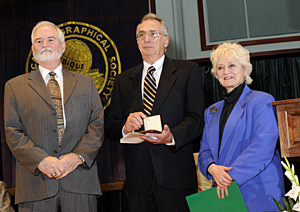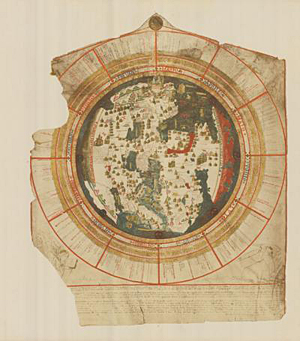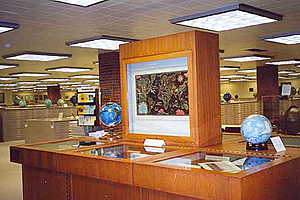


- Rozovsky wins prestigious NSF Early Career Award
- UD students meet alumni, experience 'closing bell' at NYSE
- Newark Police seek assistance in identifying suspects in robbery
- Rivlin says bipartisan budget action, stronger budget rules key to reversing debt
- Stink bugs shouldn't pose problem until late summer
- Gao to honor Placido Domingo in Washington performance
- Adopt-A-Highway project keeps Lewes road clean
- WVUD's Radiothon fundraiser runs April 1-10
- W.D. Snodgrass Symposium to honor Pulitzer winner
- New guide helps cancer patients manage symptoms
- UD in the News, March 25, 2011
- For the Record, March 25, 2011
- Public opinion expert discusses world views of U.S. in Global Agenda series
- Congressional delegation, dean laud Center for Community Research and Service program
- Center for Political Communication sets symposium on politics, entertainment
- Students work to raise funds, awareness of domestic violence
- Equestrian team wins regional championship in Western riding
- Markell, Harker stress importance of agriculture to Delaware's economy
- Carol A. Ammon MBA Case Competition winners announced
- Prof presents blood-clotting studies at Gordon Research Conference
- Sexual Assault Awareness Month events, programs announced
- Stay connected with Sea Grant, CEOE e-newsletter
- A message to UD regarding the tragedy in Japan
- More News >>
- March 31-May 14: REP stages Neil Simon's 'The Good Doctor'
- April 2: Newark plans annual 'wine and dine'
- April 5: Expert perspective on U.S. health care
- April 5: Comedian Ace Guillen to visit Scrounge
- April 6, May 4: School of Nursing sponsors research lecture series
- April 6-May 4: Confucius Institute presents Chinese Film Series on Wednesdays
- April 6: IPCC's Pachauri to discuss sustainable development in DENIN Dialogue Series
- April 7: 'WVUDstock' radiothon concert announced
- April 8: English Language Institute presents 'Arts in Translation'
- April 9: Green and Healthy Living Expo planned at The Bob
- April 9: Center for Political Communication to host Onion editor
- April 10: Alumni Easter Egg-stravaganza planned
- April 11: CDS session to focus on visual assistive technologies
- April 12: T.J. Stiles to speak at UDLA annual dinner
- April 15, 16: Annual UD push lawnmower tune-up scheduled
- April 15, 16: Master Players series presents iMusic 4, China Magpie
- April 15, 16: Delaware Symphony, UD chorus to perform Mahler work
- April 18: Former NFL Coach Bill Cowher featured in UD Speaks
- April 21-24: Sesame Street Live brings Elmo and friends to The Bob
- April 30: Save the date for Ag Day 2011 at UD
- April 30: Symposium to consider 'Frontiers at the Chemistry-Biology Interface'
- April 30-May 1: Relay for Life set at Delaware Field House
- May 4: Delaware Membrane Protein Symposium announced
- May 5: Northwestern University's Leon Keer to deliver Kerr lecture
- May 7: Women's volleyball team to host second annual Spring Fling
- Through May 3: SPPA announces speakers for 10th annual lecture series
- Through May 4: Global Agenda sees U.S. through others' eyes; World Bank president to speak
- Through May 4: 'Research on Race, Ethnicity, Culture' topic of series
- Through May 9: Black American Studies announces lecture series
- Through May 11: 'Challenges in Jewish Culture' lecture series announced
- Through May 11: Area Studies research featured in speaker series
- Through June 5: 'Andy Warhol: Behind the Camera' on view in Old College Gallery
- Through July 15: 'Bodyscapes' on view at Mechanical Hall Gallery
- More What's Happening >>
- UD calendar >>
- Middle States evaluation team on campus April 5
- Phipps named HR Liaison of the Quarter
- Senior wins iPad for participating in assessment study
- April 19: Procurement Services schedules information sessions
- UD Bookstore announces spring break hours
- HealthyU Wellness Program encourages employees to 'Step into Spring'
- April 8-29: Faculty roundtable series considers student engagement
- GRE is changing; learn more at April 15 info session
- April 30: UD Evening with Blue Rocks set for employees
- Morris Library to be open 24/7 during final exams
- More Campus FYI >>
1:20 p.m., April 21, 2009----“Secure home, promising future” -- that's the slogan that William “Bill” Roselle, director of the University of Wisconsin-Milwaukee Library, crafted in the 1970s as part of his institution's lobbying efforts for the American Geographical Society's collection of over 600,000 globes, maps, books, photographs, and other materials.
In his lecture, “A Moving Experience,” at the University of Delaware on April 17, Roselle, who retired as director of UMW's Golda Meir Library in 1989, shared the tale of the AGS Library's historic move from New York City to Milwaukee, with humor and grace.
Roselle was introduced by Susan Brynteson, vice provost and the May Morris Director of Libraries at UD. The Geography Department and UD Libraries sponsored his talk.
In the 1970s, the American Geographical Society no longer had the facilities and staff to maintain its research library as a public resource and put out the call for a new home for the collection.
Barbara Borowiecki, then chair of the geography department at UWM, approached Roselle with the idea of vying for the collection. The Milwaukee campus was only 16 years old at the time, with a library collection of 700,000 items and a staff of 12 librarians. The addition of the AGS collection would nearly double the library's size.
The transfer of the collection initially was contested by a number of parties ranging from the New York Public Library to then mayor of New York City Ed Koch. After a lengthy and complex series of negotiations, the legal proceedings finally were completed, and within days, moving vans were on site at AGS headquarters to begin the physical transfer of the collection.
Thousands of books needed to be individually wrapped in tissue paper, specially built boxes packed, and shelves installed inside the moving vans.
Among the 115,000 maps to be moved was the oldest in the collection, the Mappamundi, produced in 1452 by the Venetian cartographer Giovanni Leardo. The circular map shows the known world of only Europe, Asia, and Africa.
Roselle said the map was valued at three-quarters of a million dollars in the 1970s and was one of the few items that traveled by plane with him to Wisconsin. In fact, the map even had its own seat on the plane, Roselle said.
The transfer of the AGS Collection from New York to Milwaukee required 16 moving vans, and state police escorts from New York to Wisconsin, not because of fears of terrorism, but of losing the collection on the highway, Roselle said. The whole move was insured for $15 million.
At one rest stop in Indiana, Roselle said a group of people came over to him and a man asked if Roselle could tell them what they were transporting.
“We're moving a library,” Roselle said.
The man said, “Yeah, right.”
“We're a government agency, and that's all I'm permitted to tell you,” Roselle said.
In the end, Roselle said the move “could have been a nightmare, but it wasn't.”
Despite the fact that UMW had the smallest library staff in their peer group of university libraries, according to Roselle, there was no interruption in library services as the AGS Collection was unpacked, cleaned, and cataloged. There were no injuries to the staff throughout the process nor damages to the collection.
“We got it done and did it right,” Roselle said.
Throughout the move, Roselle said his concern was that the AGS Collection be saved, and be living, available as a public resource. Under his stewardship, the “collection” became a “library” and now numbers more than 1.2 million items. It has been described as the largest privately owned geographical research collection in the Western Hemisphere, and perhaps the world.
On April 15, at UD's Louise and David Roselle Center for the Arts, Barbara Borowiecki and William Roselle received the American Geographical Society's Samuel F. B. Morse Medal “for the encouragement of geographical research” for their “drive, dedication, and spirit” in moving the AGS library from New York City to Milwaukee in the 1970s.
Article by Tracey Bryant


